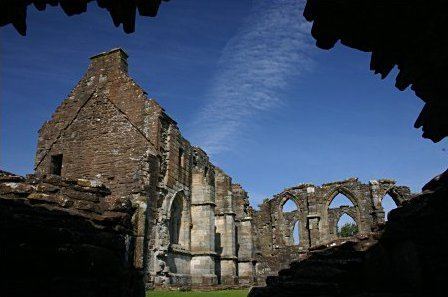Phone +44 844 742 1287 Disestablished 1617 | ||
 | ||
Controlled churches Dailly; Girvan; Inchmarnock; Kirkudbright-Innertig; Kirkoswald; Straiton Similar Barrhill railway station, Culzean Castle, Turnberry Castle, Blairquhan Castle, Dunure Castle | ||
Crossraguel abbey ayrshire
The Abbey of Saint Mary of Crossraguel is a ruin of a former abbey near the town of Maybole, South Ayrshire, Scotland.
Contents
Crossraguel abbey
Foundation
Founded in 1244 by Donnchadh, Earl of Carrick, following an earlier donation of 1225, to the monks of Paisley Abbey for that purpose. They reputedly built nothing more than a small chapel and kept the balance for themselves. The Earl took the matter to the Bishop of Glasgow for arbitration and, winning his case, forced the monks to build a proper abbey.
Name
The origin of the abbey's name refers to the ancient Cross of Riaghail (Latin form St Regulus) that stood on the spot. Crossraguel was a Cluniac abbey and the monks - members of a branch of the Benedictines - were known as the "Black monks" after the colour of their clothes.
History
Crossraguel Abbey was founded in 1244 by Duncan, 1st Earl of Carrick. The earl sought assistance from the abbot and monks of Paisley Abbey and provided them with land and funds. However, the Paisley superiors built only a small chapel for Crossraguel and kept the remainder for themselves. Upset at this, the earl took the case to law, seeking assistance from the Bishop of Glasgow, who ruled on the earl's behalf. He required not only that Paisley build the monastery at Crossraguel, but also that some of the monks from Paisley should be transferred there. These monks were given the authority to choose their own abbot. The abbot of Paisley, it was decreed, was not to interfere with Crossraguel's affairs, though he was allowed a yearly visit. All of Paisley's possessions in Carrick were to be handed over to Crossraguel, a ruling which the abbot of Paisley appealed to the pope in 1265, but to no avail.
Crossraguel was sacked in 1307 by the army of Edward I. It was rebuilt on a larger scale and remained a monastery until 1560, when the Reformation ended monastic institutions in Scotland. However, the few remaining monks were allowed to live out their time there until the last monk died in 1601. Some of the stone has been removed for local construction, but the Abbey ruins remain some of the most complete of any medieval religious house to survive in Scotland. Like Paisley Abbey, Crossraguel was of the Order of Cluny whose mission was to encourage pilgrimage. It is no accident then that Crossraguel is half-way between Paisley and Whithorn on the Ayrshire pilgrims' trail to the shrine of St Ninian in The Machars of Galloway. The site is looked after by Historic Scotland and is open to the public with an entrance charge.
The Kennedy family, Earls of Cassilis famously obtained the lands of Crossraguel Abbey through the torturing by Gilbert Kennedy, 4th Earl of Cassilis of Allan Stewart, the commendator at his castle of Dunure.
in Autumn, 1506, Montjoie (Gilbert Chauveau), French King of Arms, visited Crossraguel probably as part of his diplomatic missions regarding Scottish military support for King Hans (John) of Denmark. Montjoie had already spent time at the Court of King Henry VII of England before moving to Scotland and from there, visited Denmark. The record of him visiting Crossraguel is found in the Treasurer's Accounts of James IV, King of Scots - ‘Item, to Johne Beg, messingeir, to pas to Corsragwell and other places with writingis to warne of Montjoyis cummyng, ..... iiij s.’
